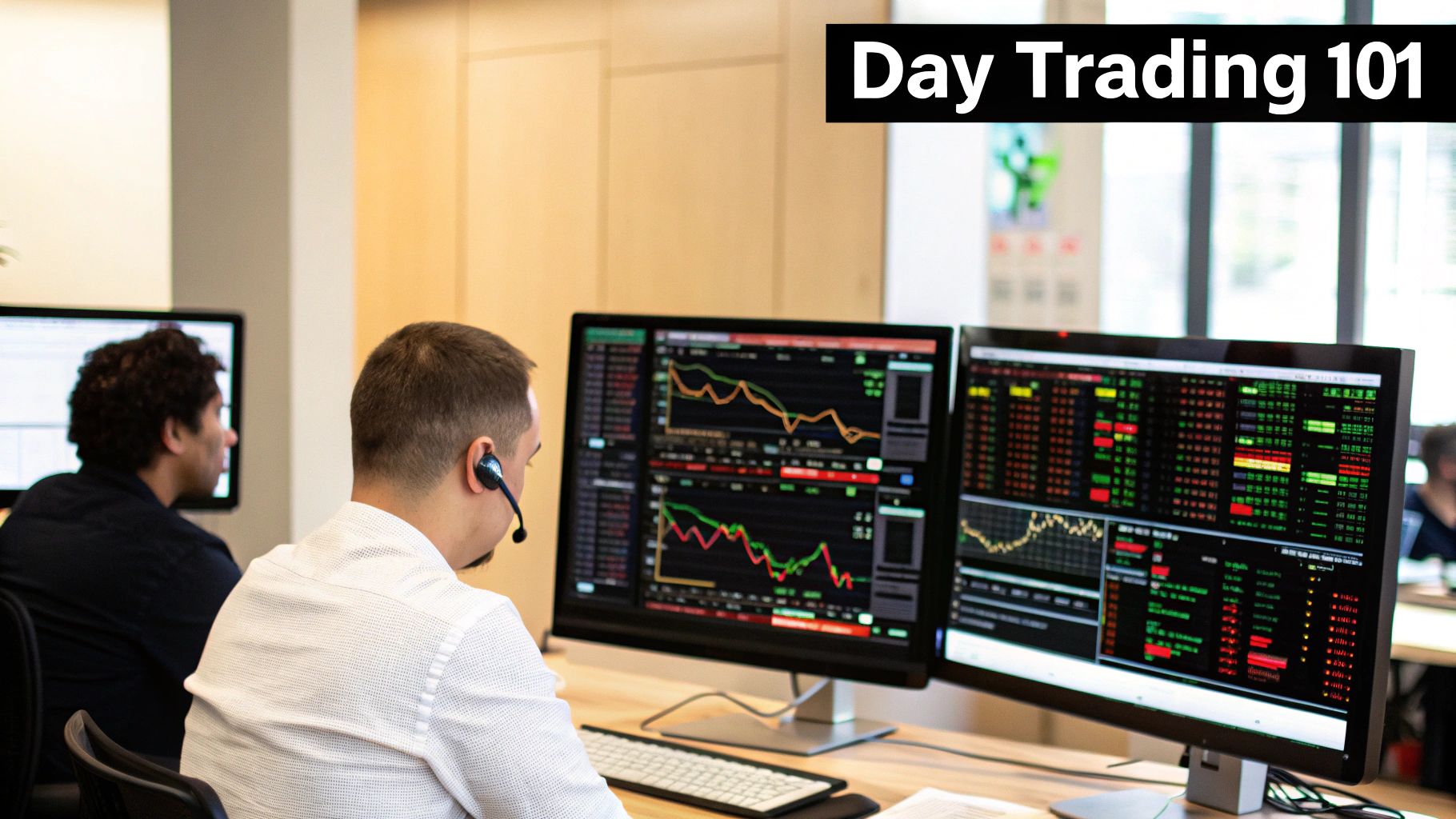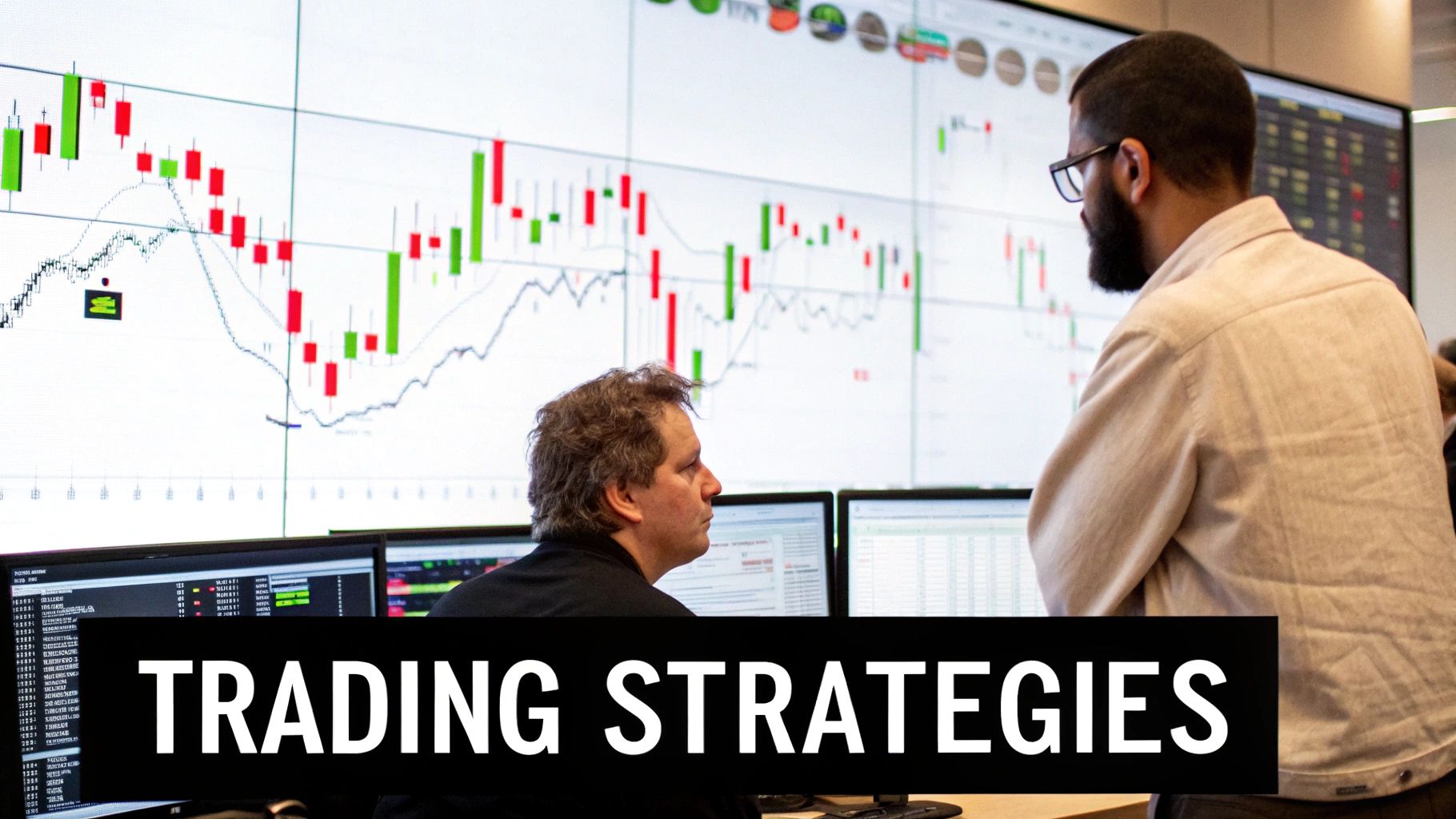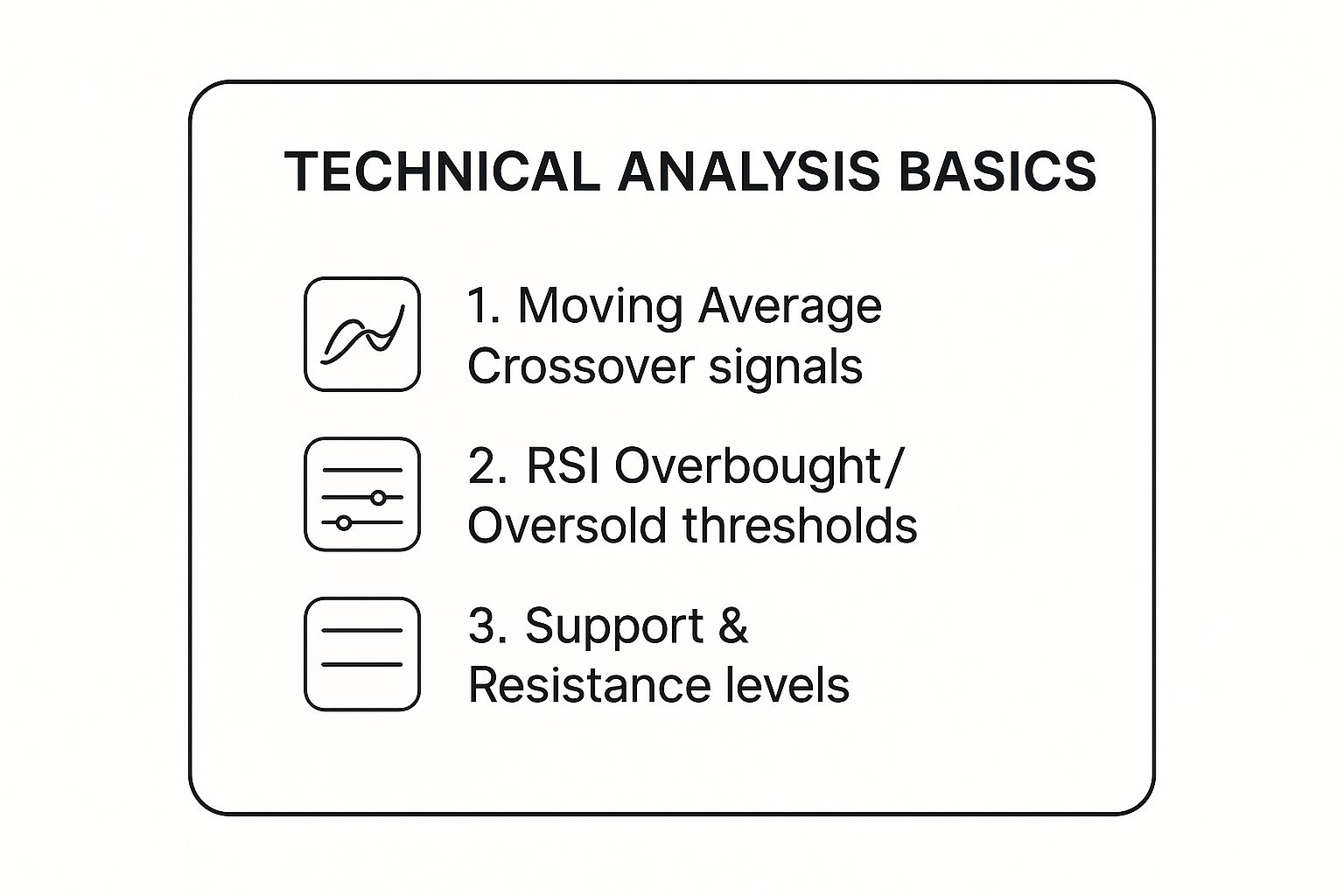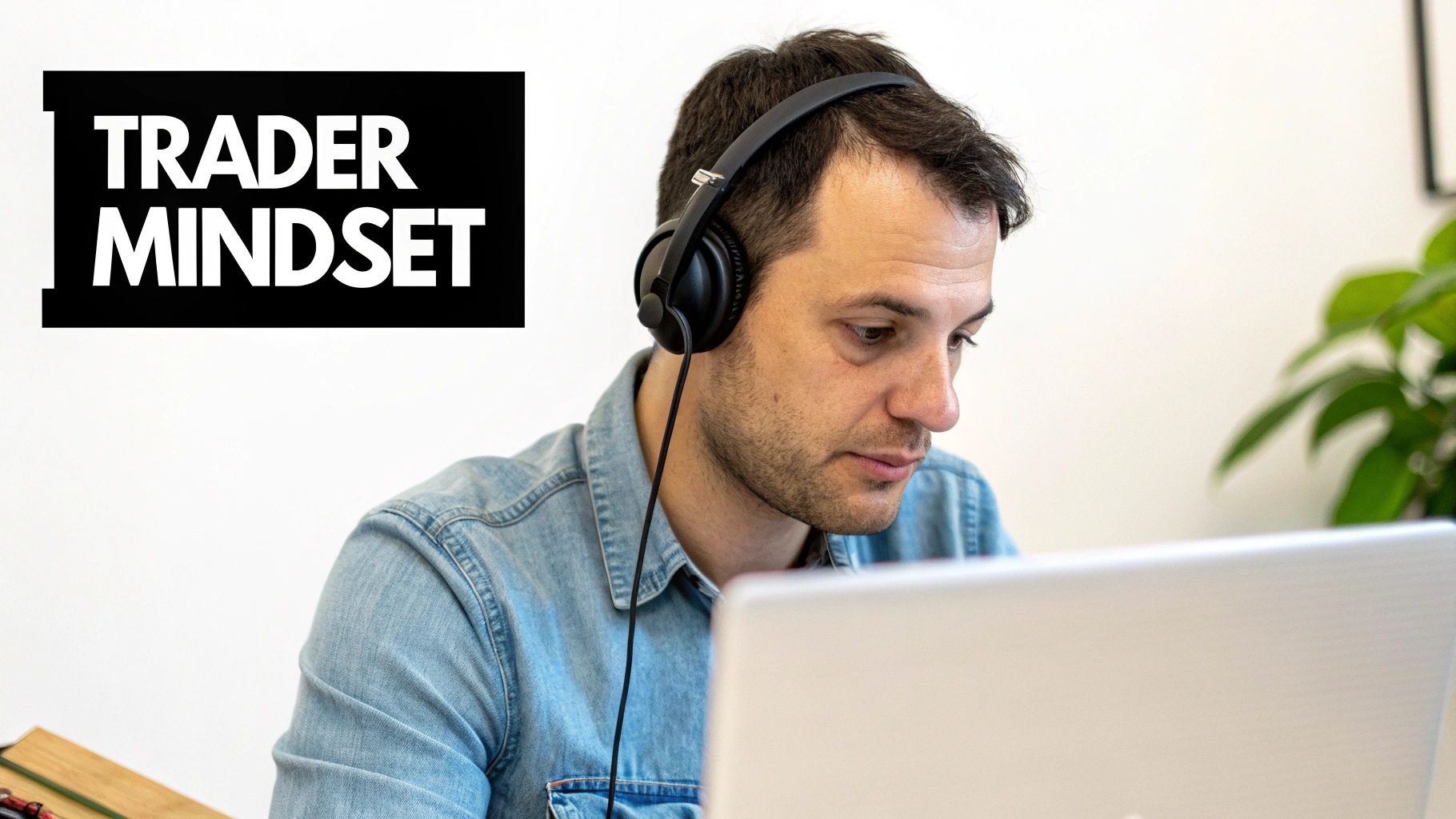Ever wondered what it's like to play the stock market on hyper-speed? That's day trading in a nutshell. It’s the practice of buying and selling financial assets—stocks, forex, crypto—all within the same trading day. Unlike traditional investing where you might hold an asset for years, a day trader closes all their positions before the market shuts down for the night. This eliminates any risk that comes from overnight news or market shifts.
What Is Day Trading and Is It Right for You?

Think of it this way: a long-term investor is like a farmer planting an orchard, patiently waiting for the trees to mature and bear fruit over many seasons. A day trader, on the other hand, runs a high-speed pop-up shop. They buy in-demand products and flip them within hours, or even minutes, for a small profit on each sale. Individually, these gains are tiny. But when you make hundreds of these quick transactions, they can start to add up.
This approach demands intense focus, lightning-fast decisions, and a gut-level feel for how the market breathes.
Let's get one thing straight: day trading is not a get-rich-quick scheme. It’s a serious discipline, and your mindset is everything. You have to keep your emotions in check. Fear and greed are the two biggest account killers, pushing traders into impulsive moves that lead to devastating losses. The ones who make it treat trading like a business—they show up every day with a clear plan, defined goals, and iron-clad rules.
To give you a clearer picture, here’s a quick breakdown of what day trading entails.
Day Trading at a Glance
| Characteristic | Description |
|---|---|
| Timeframe | Trades are opened and closed within a single trading day. No positions are held overnight. |
| Goal | To profit from small, rapid price fluctuations in highly liquid assets. |
| Strategy | Relies heavily on technical analysis, chart patterns, and real-time market data. |
| Risk | High-risk due to leverage and volatility, but overnight market risk is eliminated. |
| Mindset | Requires extreme discipline, emotional control, and the ability to make quick, logical decisions under pressure. |
This table shows that day trading is a very specific, high-intensity activity. It’s not for everyone, and it’s important to understand the realities before diving in.
The Reality of Day Trading Success
While the allure of high profits is strong, the hard truth is that most people who try day trading fail. The learning curve is brutally steep and the mental pressure is relentless.
Statistically, only about 13% of day traders manage to stay consistently profitable for six months. Even more sobering, a tiny 1% maintain that success for more than five years. Despite these tough odds, day traders are a vital part of the ecosystem. They provide essential liquidity and account for roughly 12% of the daily trading volume on major exchanges like the NYSE. You can dig deeper into these day trading statistics on QuantifiedStrategies.com.
This all highlights a crucial point: day trading isn't a casual hobby. It demands serious capital, a well-tested strategy, and unwavering discipline. Before you even think about placing your first trade, you need to have an honest conversation with yourself.
Ask yourself these questions:
- Can I truly separate my emotions from my money?
- Am I disciplined enough to stick to my trading plan, even on a losing streak?
- Do I have the time to dedicate to constant market analysis and active trading during market hours?
Your honest answers will be your first, and most important, step into the real world of day trading.
Of course. Here is the rewritten section, following all the specified guidelines for style, tone, and formatting.
Understanding the Language of the Market
Before you ever click "buy," you need to speak the market's language. Getting a handle on the core concepts of day trading isn't just academic—it's about learning to read the environment so you can make smarter, faster decisions. The three big ones to master right away are liquidity, volatility, and your basic order types.
Think of liquidity as the crowd at a concert. A popular blue-chip stock is like a headline act; thousands of people are ready to buy or sell tickets (shares) at a moment's notice. You can get in and out of your position effortlessly. An illiquid asset, on the other hand, is like a niche indie band. It might have value, but finding a buyer at the price you want can take a while, leaving you stuck in a trade you'd rather exit.
For day traders, high liquidity is non-negotiable. You need to execute trades instantly without the price slipping away from you.
Navigating Market Weather with Volatility
If liquidity is about how easily you can trade, volatility is all about how much the price actually moves. For a trader, it’s like the weather is for a sailor.
- Low Volatility: This is a dead calm sea. Sure, it's safe, but your boat isn't going anywhere. No price movement means no profit opportunities.
- High Volatility: Now you're in a raging storm. There’s a ton of movement, but the risk of your boat capsizing (a massive loss) is through the roof.
Day traders aren't looking for tsunamis; they're looking for predictable waves. The goal is to find that sweet spot with just enough price action to create opportunities, but not so much that trading turns into a casino trip.
A trader's goal is not to conquer the storm but to skillfully ride the waves. Understanding volatility helps you know when to set sail and when to stay in the harbor, protecting your capital for another day.
Giving Your Broker Clear Commands
Finally, you need to know how to actually place a trade. Your instructions to your broker are called order types, and they're the primary tools you'll use to execute your strategy and, just as importantly, manage your risk. Here are the three essential commands you must know:
- Market Order: This is the simplest command: "Get me in or out right now at the best available price!" It guarantees your trade gets filled instantly, but it doesn't guarantee the exact price you'll get.
- Limit Order: This command is far more precise: "Buy or sell only at this specific price or a better one." This gives you total control over your entry or exit price, but there's no guarantee the trade will execute if the market never hits your target.
- Stop-Loss Order: This is your financial seatbelt and arguably the most critical command for survival. It’s a standing instruction to automatically sell your position if it drops to a certain price, preventing a small, manageable loss from turning into a catastrophic one.
Building Your Day Trading Toolkit

Think a successful day trader just wings it on skill alone? Think again. They're armed with a specific set of tools for the job. It's like a detective showing up to a crime scene—you wouldn't expect them to solve the case with just a hunch. They need fingerprint kits, magnifying glasses, and evidence bags.
For a trader, those tools are your platform, your charts, and your news feed. Your entire setup rests on three essential pillars. You don't need a Wall Street budget, but what you do need are tools that are fast, reliable, and give you crystal-clear information. A laggy platform or old data can flip a winning trade on its head in a heartbeat.
The Three Pillars of Your Toolkit
Your success in the markets really boils down to the quality of your core setup. Get these three things right from day one, and you'll have a solid foundation to build on.
- A Lightning-Fast Trading Platform: This is your command center, where you execute every buy and sell order. Look for a broker with low latency, which is just a fancy way of saying your trades go through almost instantly. Low fees are a nice perk, but speed and reliability are what make or break you when every second counts.
- Powerful Charting Software: Charts are your roadmap to the market. They let you look back at past price action to get a better sense of where things might be headed. Good software makes it easy to draw trend lines, apply technical indicators, and spot chart patterns as they form. The good news? Many top-tier brokers include excellent charting tools for free.
- A Real-Time News Source: Big news can send prices soaring or send them into a nosedive without any warning. A real-time news feed is your early-warning system, alerting you to economic data releases, surprise company announcements, and global events that can shake up your trades.
Your toolkit isn't just about clicking "buy" or "sell." It's about making smart, informed decisions. The right tools are what give you the clues to piece together the market's next move—much like a detective solving a complex puzzle.
Nailing this down is fundamental to mastering day trading basics. As you gain more experience, you can layer on more specialized tools, but these three are the non-negotiable foundation for any aspiring trader.
To see how market mood plays into all this, check out our guide on using the stock Fear and Greed Index to your advantage.
Why Do So Many New Traders Start with Forex?
To really get the hang of day trading, it helps to look at a market that lives and breathes it. For a lot of newcomers, that market is foreign exchange (forex). It’s not just that it's the biggest financial market on the planet; its very structure seems almost tailor-made for the rapid-fire nature of day trading.
Think of it as a global marketplace that literally never closes. While the New York Stock Exchange punches a clock, the forex market is open 24 hours a day, five days a week. It’s a continuous session that follows the sun, starting in Sydney, moving through Tokyo and London, and ending in New York. This around-the-clock action gives you the freedom to trade whenever it suits you—a massive plus compared to other markets.
The Power of Massive Liquidity
The sheer scale of the forex market is hard to wrap your head around, but its size creates something absolutely essential for day traders: liquidity. High liquidity just means you can buy or sell huge amounts of currency almost instantly without causing a major price swing. It's like being able to easily exchange a $100 bill for smaller notes anytime, anywhere. There's always someone on the other side of the trade.
For a day trader, liquidity isn't just a perk; it's everything. It's what ensures you’re never “stuck” holding a position you need to exit, giving you the sharp, precise execution your strategies demand.
The numbers are simply staggering. Back in April 2022, the average daily trading volume in forex topped $7.51 trillion. The most traded currency pair, the EUR/USD, made up $1.71 trillion of that volume all by itself—that's nearly 23% of all forex activity. If you want to dig into these figures, BestBrokers.com has some great insights on forex trading volume.
This combination of massive volume and non-stop access makes forex a natural training ground. The constant, relatively predictable ebb and flow of major pairs like the EUR/USD provides a perfect environment for learning to read charts and test out fundamental trading strategies.
The Unbreakable Rules of Risk Management
If you take only one thing away from this guide, let it be this: risk management separates professional traders from gamblers. It’s not about capping your profits; it’s about making sure you stay in the game long enough to become profitable. One bad trade, left to run wild, can wipe out weeks of hard-earned gains.
Think of it like a pilot's pre-flight checklist. It's a non-negotiable discipline you perform on every single flight—or in your case, every single trade—to prevent disaster.
The 1% Rule: Your Financial Seatbelt
The most crucial rule in any day trading playbook is the 1% rule. The idea is simple but incredibly powerful: never risk more than 1% of your total account value on any single trade.
If you have a $10,000 trading account, your maximum potential loss on one trade should be just $100. This rule acts like a financial seatbelt, stopping any single bad decision or surprise market move from causing catastrophic damage to your capital.
Following this rule is also a secret weapon for keeping your emotions in check. When you know your maximum loss is small and manageable, you're far less likely to make panicked, fear-driven decisions.
This infographic lays out a few key technical analysis concepts that traders often use to pinpoint entry and exit points, which is fundamental to managing your trades effectively.

Tools like support levels or RSI thresholds help you define exactly where you'll cut a loss, which is what makes applying the 1% rule practical in the real world.
Risk Management Rules of Thumb
To make these concepts stick, here’s a quick-reference table with some foundational rules. Think of this as your cheat sheet for trading survival.
| Rule | What It Means | Why It's Important |
|---|---|---|
| The 1% Rule | Never risk more than 1% of your total account on a single trade. | Prevents a single bad trade from wiping out your account. |
| Set Stop-Loss Orders | Predetermine the price at which you will exit a losing trade. | Automates discipline and removes emotion from cutting losses. |
| Know Your Risk/Reward | Only enter trades where the potential profit is greater than the potential loss (e.g., 2:1 ratio). | Ensures your winning trades will outweigh your losing trades over time. |
These rules aren't meant to be restrictive; they're designed to build a professional, sustainable trading career.
Remember, your goal isn't to be right on every single trade—that’s impossible. Your goal is to make sure your winning trades are bigger than your losing ones. To dig deeper into these core strategies, check out our complete guide on mastering day trading risk management.
Your First Steps with a Practice Account

Theory can only get you so far. To really get day trading, you have to move from reading to doing. But here’s a pro tip: jumping straight into the live market with your own money is a classic rookie mistake.
Your first real step should be opening a paper trading account. You’ll also hear it called a demo account or a trading simulator. Think of it as a flight simulator for traders. You get to fly in a real-time market, execute trades, and test out strategies, but it's all with fake money. It’s your own personal lab to apply what you’ve learned, completely risk-free.
Mastering the Mechanics Safely
The point of a practice account isn't to make a pretend fortune. It's about building muscle memory and confidence. This is where you learn the nuts and bolts of your trading platform—how to place a market order, how to set a stop-loss, and how to read a chart—without the gut-wrenching fear of losing real cash.
A practice account is where you make your first mistakes, learn your first hard lessons, and feel the emotional rollercoaster of trading without it costing you a dime. It turns abstract knowledge into a practical skill.
And there's never been a more dynamic time to practice. Electronic markets have exploded. In January alone, the total global trading volume hit $54.6 trillion. That breaks down to an average daily volume of $2.44 trillion, a jump of 20.3% from the previous year. You can get more details on this growth and its impact on trading volumes over at Tradeweb.com.
Here's a simple action plan to get you started:
- Choose Your Broker: Find a reputable broker that offers a solid, realistic demo platform.
- Test Your Strategies: Start applying the concepts you've been learning. See what works—and more importantly, what doesn't—in live market conditions.
- Track Your Performance: Keep a detailed trading journal. Write down your wins, your losses, and why you made each trade.
This process is invaluable. It’s how you build the competence you absolutely need before you even think about putting real capital on the line.
Common Questions About Day Trading
Alright, let's get into the questions every aspiring trader eventually asks. Getting straight, no-nonsense answers is key to setting the right expectations as you start your journey.
How Much Money Do I Need to Start?
You'll see people claim you can start with a few hundred bucks, but honestly, that's not a great idea. If you want to actively day trade stocks in the US, you’re legally required to keep a $25,000 minimum balance in your account to get around the Pattern Day Trader (PDT) rule.
While markets like forex or crypto don't have this requirement, starting too small makes it almost impossible to manage risk properly.
A small account basically forces you to bet the farm on every single trade. It's a classic recipe for blowing up your account. You want enough capital to comfortably stick to the 1% risk rule without sweating every tick.
Can Day Trading Fit Around a Full-Time Job?
It’s tough, but not impossible—especially with markets that run 24 hours, like crypto or forex. The real challenge is that proper day trading demands your full, undivided attention when the market is moving.
Trying to sneak in trades while you're distracted at your 9-to-5 is a surefire way to make bad decisions and lose money. Many traders find their footing with swing trading first before making the leap to full-time day trading.
Day Trading vs. Swing Trading
The biggest difference here is simply time. Day traders are in and out of all their positions before the market closes for the day. No overnight exposure.
Swing traders, on the other hand, hold on for a bit longer—maybe a few days or even a couple of weeks—to catch a bigger price "swing." Because it’s less intense, swing trading is often a much more practical starting point for people with busy schedules.
No matter which style you lean toward, understanding the psychology driving the market is non-negotiable. To get a better handle on this, check out our guide on how to use market sentiment analysis for trading.
